Alfred Brooks, 1809 - 1865
by Brian Stevenson
last updated January, 2020
Alfred Brooks was a relatively minor manufacturer of scientific instruments during the mid-1800s, yet he produced microscopes of unique design that are worthy of discussion (Figures 1 and 2). Brooks claimed to have worked for the Dollond optical business for “upwards of twenty years” before establishing his own shop in 1848. He filed for bankruptcy in 1860, then got out of the instrument-making business altogether (he bought a pub). The brief duration of Brooks’ small business likely accounts for the relative scarcity of his instruments nowadays.
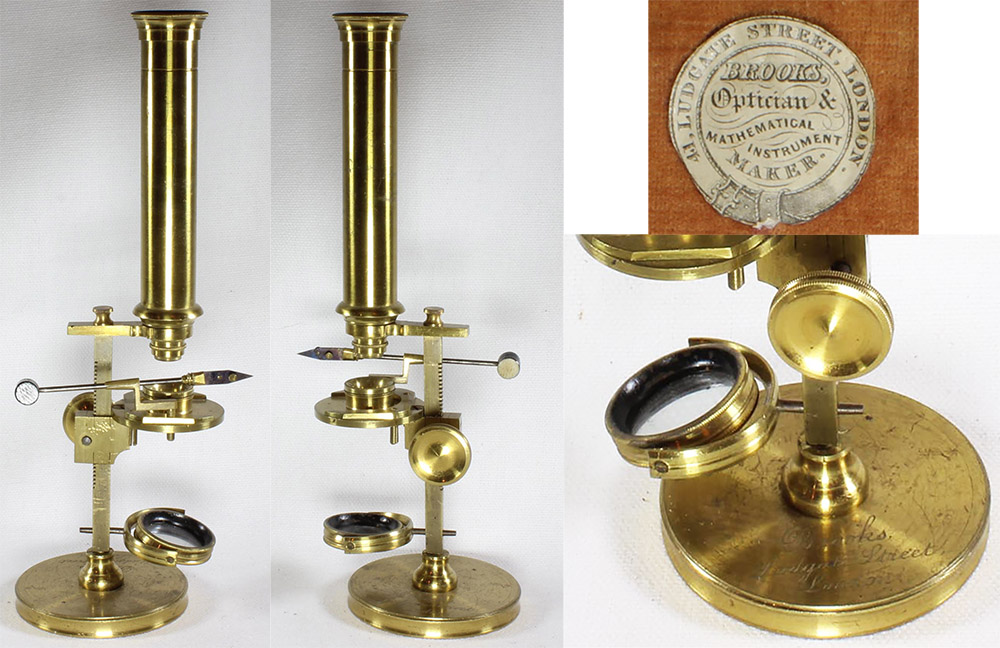
Figure 1.
A compound microscope by Alfred Brooks, with unique design features. The rectangular upright and the stage mount resemble those found on earlier “Cary-Gould”-type microscopes, with focus by rack-and-pinion that adjusts the height of the stage. However, the large stage is circular, and affixed to the stage mount by a screw. The instrument is mounted on a large brass disc, engraved “Brooks, Ludgate Street, London”, and packs into a case that bears Brooks’ trade label. Adapted by permission from http://www.microscope-antiques.com/brooks.html.
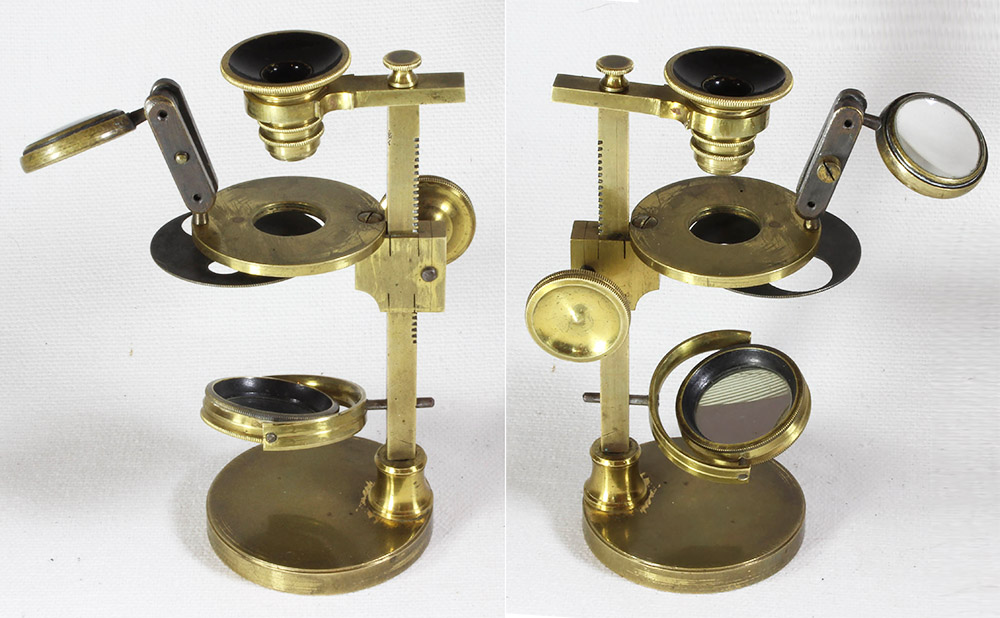
Figure 2.
An unsigned, simple microscope that shares many of the features of the Brooks compound microscope that is shown in Figure 1, suggesting that this was also made by him. The only apparent differences are the simple lens in place of the compound body, a substage that consists of a wheel of stops, and attachment to the edge of the base. Two other identical microscopes are known, both of which are also unsigned. Adapted by permission from http://www.microscope-antiques.com/brooksbotanical.html.
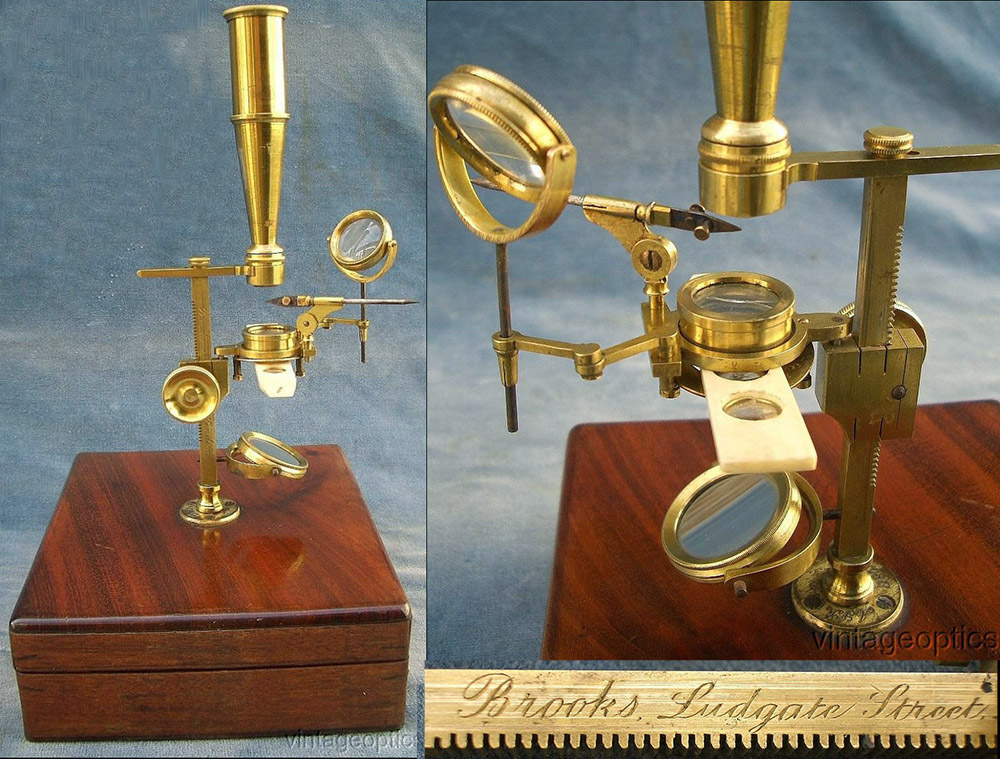
Figure 3.
A standard “Cary-Gould”-type case-mounted microscope, engraved “Brooks Ludgate Street”. Adapted for nonprofit, educational purposes from an internet auction site.
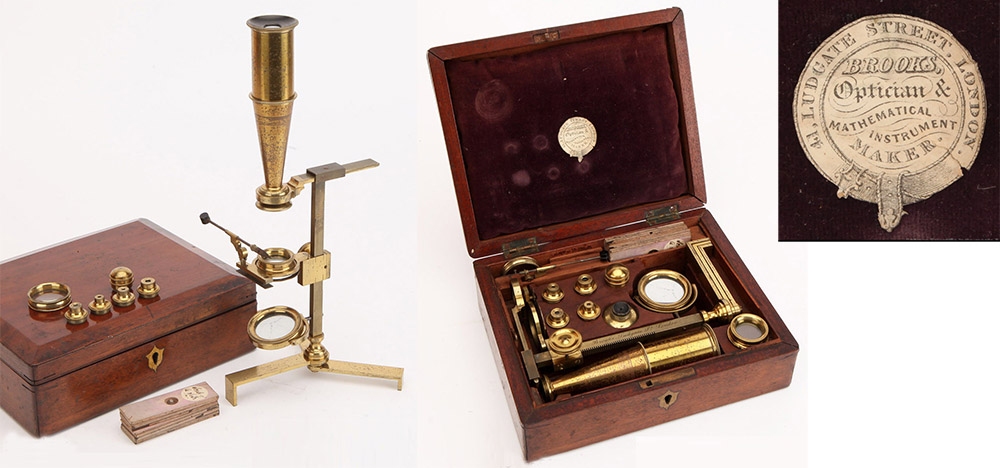
Figure 4.
A tripod-mounted microscope, sharing some features of the three instruments shown above in Figures 1-3. A Brooks trade label is glued to the inside of the case lid. Adapted for nonprofit, educational purposes from an internet auction site.
Alfred Brooks was born on September 23, 1809 in London’s Saint Sepulchre parish, to William John and Mary Brooks. Father William was a barber/hair dresser, and a member of the Barber’s Guild. Alfred was admitted to that guild on October 26, 1836, by patrimony. By that time, guild membership brought important connections and privileges, but was not necessarily indicative of one’s occupation.
When Alfred established his business in 1848, he claimed to have had “upwards of 20 years’ experience” with Dollond, implying that he began working there when approximately 19 years old. He may have begun to learn the trade at that time and place. Alternatively, boys often started apprenticeships when 14-15 years old, so Brooks may have apprenticed elsewhere, then later joined Dollond. Joining the Barbers’ Guild by patrimony was probably easier and cheaper than joining the Scientific Instrument Makers’ or another, more relevant, guild.
Alfred Brooks married Elizabeth Ratcliff on August 15, 1840. For him to have married suggests that he had a decent, stable income, and so may have been working in the upper echelons of Dollond’s business. On his marriage record, Alfred described himself as being a “gentleman”.
A son was born the following August, but both the child and Elizabeth died in early 1843.
According to his advertisements, Alfred left Dollond and opened his own shop in 1848 (Figure 5). Brooks’ shop at 41 Ludgate Street was a short walk from Dollond’s shop in St. Paul’s Churchyard. He offered “spectacles, telescopes, microscopes, opera and race glasses, sextants, quadrants, compasses, barometers, surveying instruments, rules, scales, &c., of every description” (Figures 5-7). It was a modestly-sized business: the 1851 census reported that Brooks employed 1 man and 1 boy.
In 1857, Brooks remarried, to Ann Moss, who was some 19 years his junior. They had two children, Annie Eliza and Alfred William.
Alfred Brooks petitioned for bankruptcy protection on December 28, 1860, which was apparently resolved later in the spring of 1861.
He then became a “licensed victualler”, and acquired “The Falcon” tavern on Pemberton Row, Gough Square, in London. Alfred died on November 25, 1865, when only 56 years old. His wife, Ann, and their children continued to operate “The Falcon” well into the twentieth century.

Figure 5.
Advertisements from Alfred Brooks. The 1849 advertisement, from April 7, 1849 issue of “The Gardeners’ Chronicle and Agricultural Gazette”, was published soon after Brooks established his shop.
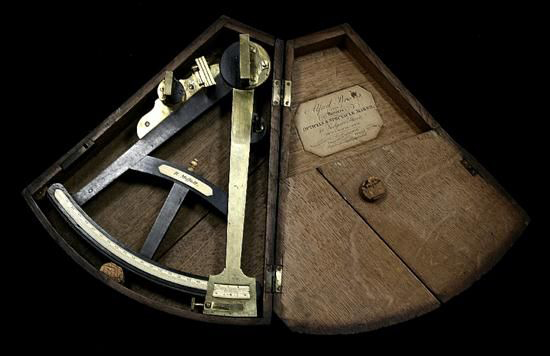
Figure 6.
A quadrant by Alfred Brooks. Adapted for nonprofit, educational purposes from an internet auction site.

Figure 7.
A barometer by Alfred Brooks. Adapted for nonprofit, educational purposes from an internet sales site.
Acknowledgements
Thank you to Barry Sobel for permission to use images from microscope-antiques.com, and to Joe Zeligs and Jeff Silverman for insightful discussions.
Resources
The Athenaeum (1853) Advertisement from Alfred Barnes, in multiple issues
Cunningham, Peter (1851) Modern London, J. Murray, London, includes advertisement from Alfred Barnes
England census and other records, accessed through ancestry.com
The Gardeners' Chronicle and Agricultural Gazette (1849) Advertisement from Alfred Barnes, Vol. 9, page 224
Marriage record of Alfred Brooks and Elizabeth Biggs Harbin Ratcliff (1840) Parish records of St. Mary Barnes, accessed through ancestry.com
Marriage record of Alfred Brooks and Ann Moss (1857) Parish records of St. Mary Islington, accessed through ancestry.com
Probate of the will of Alfred Brooks (1865) “The Will of Alfred Brooks late of the “Falcon” Tavern Pemberton-row Gough-square in the City of London Licensed Victualler deceased who died 25 November 1865 at the “Falcon” Tavern aforesaid was proved at the Principal Registry by oath of Ann Brooks of the “Falcon” Tavern aforesaid Widow the Relict the sole Executrix. Effects under £450”, accessed through ancestry.com
Pubwiki (accessed January, 2020) Falcon Tavern, 4 Pemberton row, Fleet street EC4, https://pubwiki.co.uk/LondonPubs/HolyTrinityLess/Falcon.shtml
The Solicitors' Journal & Reporter (1861) “Bankrupts: … Brooks, Alfred, Optician. 41, Ludgate-street, London. Com. Holroyd: Jan. 12, and Feb. 16, at 12; Basinghall-street. Off. Ass. Edwards. Sols. Lumley & Lumley, 41, Ludgate-hill, London. Pet. Dec. 28”, Vol. 5, page 172






